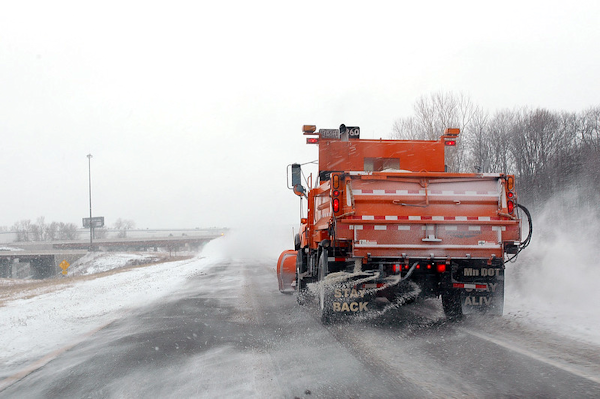SEJournal Online is the digital news magazine of the Society of Environmental Journalists. Learn more about SEJournal Online, including submission, subscription and advertising information.
 |
| A truck applying road salt during a winter storm in Minnesota. Sodium chlorides can pollute local waterways, threatening the environment and human health. Photo: Minnesota Department of Transportation/David R. Gonzalez via Flickr Creative Commons (CC BY-NC 2.0). |
TipSheet: Road Salt Spreading a Slippery Slope to Water Pollution
By Joseph A. Davis
If you have driven an interstate during a snow emergency, you know that road salt can be a problem.
But keeping your windshield clear is the least of it. The large amounts of salt (and other de-icers) spread on winter roads eventually end up in water and soil. There’s a good chance they are hurting the environment.
With more than 20 million tons of it spread on U.S. roads in a typical year, environmental journalists should be able to find stories about how road salt (and associated policies and practices) affects their locality or region.
Why it matters
A lot of road salt is simply salt — sodium chloride — which is fine on food but not fine if it is rusting out the rocker panels of your car from the inside.
More urgently, chlorides can pollute both surface lakes and streams and groundwater. When the salt gets into water, it dissolves easily, creating chloride ions that cause havoc.
High chloride concentrations can
harm aquatic life. And if they contaminate
drinking water sources, more treatment
is required to protect human health.
High chloride concentrations can harm aquatic life, including fish, insects and freshwater mussels. If they contaminate drinking water sources, more treatment is required to protect human health.
Also, you can often see harmful effects of de-icing salt on grass and bushes near roads and sidewalks. And if you have ever walked your pet on a salty sidewalk, you probably know salt can hurt their paws.
The backstory
When the Clean Water Act of 1972 called for fishable, swimmable waters, it meant to control all water pollutants, including chlorides. The U.S. Environmental Protection Agency sets “criteria” for pollutants, to guide states in setting their own water quality standards to protect designated uses of particular water bodies.
The Safe Drinking Water Act also sets standards — particularly for the treated drinking water that flows into pipes and out of faucets. The EPA has set a secondary standard for chloride in drinking water at 250 mg/L.
One problem is that salt does not
just come out of the end of a
single pipe; it is diffuse and
enters water bodies in many places.
One problem is that salt does not just come out of the end of a single pipe; it is diffuse and enters water bodies in many places. So control of it is most effectively done by limiting the ways we apply it. And, most importantly, not applying more than we need to.
Less road salt needs to be applied if crews follow certain practices meant specifically to minimize chloride pollution.
One of those practices is the use of abrasives like sand. Salt on roads is meant to keep people from slipping, and abrasives do just that, meaning less salt needs to be applied. It is, however, important that abrasives not themselves be potentially toxic — such as coal ash.
Road crews have evolved other tricks. Adding beet juice to the salt, it turns out, lowers the freezing point of water below that for salt alone, making less salt necessary. Applying the salt ahead of the snow, in the form of brine, also helps.
There are other salt alternatives, such as calcium chloride, calcium magnesium acetate or potassium acetate that work also. But these may be more expensive.
Questions to ask, story ideas
- Which agencies (local, state or federal) spread salt on which roads in your area? What are their salt policies?
- What salt alternatives are used on your local roads?
- Visit some local hardware or grocery stores. What de-icing products do they offer?
- What are the chloride levels in your local lakes and streams? What effects do they have on fish and wildlife? On people?
- What are the chloride levels of the source water going into your local drinking water treatment system?
- Test the chloride levels in lakes and streams near you. Test kits are available from groups like Salt Watch.
- Go to your local road-maintenance yard and talk to the drivers and other staff about how they keep the roads drivable.
Reporting resources
- The EPA: The agency oversees state implementation of the Clean Water Act and Safe Drinking Water Act.
- State or local road-maintenance agencies: That big dome protecting a humongous pile of road salt may very well be owned by your city or county.
- Salt Smart Collaborative: A nonprofit group aimed at minimizing the environmental impact of road salt.
- Salt Watch: A project of the Izaak Walton League to encourage reduction of water pollution from road salt.
- ASDWA: The Association of State Drinking Water Administrators is a professional and lobby group of state officials.
Joseph A. Davis is a freelance writer/editor in Washington, D.C. who has been writing about the environment since 1976. He writes SEJournal Online's TipSheet, Reporter's Toolbox and Issue Backgrounder, and curates SEJ's weekday news headlines service EJToday and @EJTodayNews. Davis also directs SEJ's Freedom of Information Project and writes the WatchDog opinion column.
* From the weekly news magazine SEJournal Online, Vol. 8, No. 6. Content from each new issue of SEJournal Online is available to the public via the SEJournal Online main page. Subscribe to the e-newsletter here. And see past issues of the SEJournal archived here.













 Advertisement
Advertisement 



